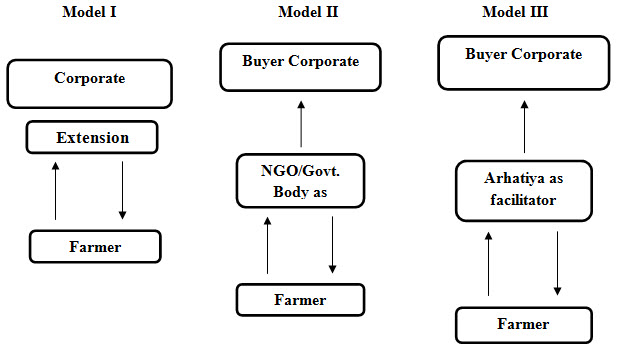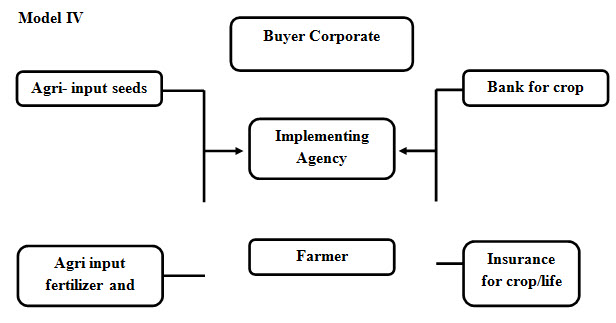Site pages
Current course
Participants
General
Module 4. Concepts and application of management p...
Lesson-22 Contract Farming
22.1 INTRODUCTOIN
Farming is an age-old means of livelihood for millions of Indians. However, there have been few systems/models in which farmers are assured of a market for their produce, leave alone a remunerative price. Farmers have on occasion had to throw their produce away for want of buyers. This is one side of the coin. On the other is the agri-based and food industry, which requires timely and adequate inputs of good quality agricultural produce. This underlying paradox of the Indian agricultural scenario has given birth to the concept of Contract Farming, which promises to provide a proper linkage between the ‘farm and market’.
22.2 MEANING AND FEATURES OF CONTRACT FARMING
Meaning: Contract farming is defined as a system for the production and supply of agricultural/horticultural produce under forward contracts between producers/suppliers and buyers. The essence of such an arrangement is the commitment of the producer/ seller to provide an agricultural commodity of a certain type, quality, at a time and a price, and in the quantity required by a known and committed buyer.
Some authors trace the principles of contract farming back to the 19th century, when the mechanism was used in the United States for processing crops such as sugar beets and peaches, and in Taiwan, for sugar production under the Japanese colonial rule. Its use later expanded into many food and fiber sectors.
22.3 SALIENT FEATURES OF CONTRACT FARMING:
The industry or the prospective buyer enters into a contract with the farmer
The industry promises to buy the farmer’s produce
The farmer harvests and delivers to the contractor, a quantum of produce, based upon anticipated yield and contracted acreage
Price and other terms and conditions are pre-negotiated between the farmer and the buyer. The buyer supplies the required farm inputs at the required time. Sponsors may also provide land preparation, field cultivation and harvesting as well as free training and extension. This is primary to ensure that proper crop husbandry practices are followed in order to achieve projected yields and required qualities
Farmers will not cultivate and diversity into new crops unless they know they can sell their crop, and traders or processors will not invest in ventures unless they are assumed that the required commodities can be consistently produced. Contract farming offers a potential solution to this situation by providing market guarantees to the farmers and assuring supply to the purchases.
Contract farming usually allows farmers access to some form of credit to finance production inputs. In most cases it is the sponsors who advance credit through their managers. However linens that are guaranteed by the sponsor, i.e. the contract serve as collateral. The tendency of certain farmers to abuse credit arrangements by selling crops to buyers other than the sponsor (extra-contractual marketing), or by diverting inputs supplied by management to other purposes, has caused come sponsors to reconsider supplying most inputs, opting instead to provide only seeds and essential agrochemicals.
22.4 MODELS IN CONTRACT FARMING
Contract farming can be structured in a variety of ways depending on the crop, the objectives and resources of the sponsor and the experience of the farmers. Contracting out production is a commercial decision to facilitate an adequate supply within a designated period and at an economic price. Any crop or livestock product can theoretically be contracted out using any of the models; however, certain products favour specific approaches. The most popular contract farming models are schematically presented below (Fig. 22.1). The features of each models is given in table 22.1 and the list of companies operation in different modes is given in table 22.2.
Fig. 22.1. Models in contract farming


Note: For model agreement for contract farming scheme in Gujarat, you can follow the link http://agri.gujarat.gov.in/boards_corporations/gs-agri-mark-board/schemes/contract-farming/model-agreement.htm
Table 22.1 Comparison of Contract Farming Models in India
|
Component |
Model I |
Model II |
Model III |
Model IV |
|
Cost increments due to channel partners |
Nil |
Minimal |
Considerable |
Maximum |
|
Scale of operations |
Can be taken up with smaller scale of operations |
Can be taken up with smaller scale of operations |
Applicable for large scale of operations |
Applicable for large scale of operations |
|
Channel Partners |
No channel partners |
Non profit organizations as partners |
Traditional channel members as partners |
Corporates act as channel partners |
|
Transparency in price fixation |
Completely Transparent |
Transparent |
Low transparency |
Lower Transparency |
|
Services offered to the farmer |
Only extension services other services subjective to the operating company |
Extension services and other services at the discretion of the contracting firm |
Extension services and other associated services such as loans and other inputs |
Wide range of services ranging from the crop loan to life insurance are taken care |
Source: NIAM
Table 22.2: Grouping of major contract farming initiatives of corporates under different models
|
Type |
Initiative |
Crop |
State |
|
Type I |
Nijjer Agro Tinna Oils SNC Oil AVT Natural Products Ltd Natural Remedies Pvt Ltd Himalaya Drugs Pvt Ltd PepsiCo |
Tomato & Chilly Soyabean Dhavana Marigold Coleus Ashwagandha Basmati |
Punjab Maharashtra Karnataka Karnataka Karnataka Karnataka Punjab |
|
Type II |
Ion Exchange Enviro Farms |
Organic Produce |
Maharashtra |
|
Type III |
United Breweries Ltd ITC-IBD |
Barley Soyabean, Wheat |
Punjab Madhya Pradesh |
|
Type IV |
MSSL
Escorts Machinery Group Super Spinning Mills Cargill India Pvt Ltd
Appachi Cotton India Gherkin Exporters
|
Basmati, Non-Basmati, Maize Basmati Cotton Soyabean, Wheat, Maize
Cotton Gherkin |
Punjab, Tamil Nadu
Punjab Tamil Nadu Madhya Pradesh & Uttar Pradesh Tamil Nadu Karnataka, Tamil Nadu, Andhra pradesh |
22.5 ADVANTAGES AND DISADVANTAGES OF CONTRACT FARMING
We turn now to examine the potential advantages and disadvantages of this mode of governance for the actors involved in the transactions.
A useful instrument for public policy design is offered by stakeholder analysis, which among other things tries to identify who stands to win or lose from a policy choice and assess what is the extent of their potential gains and losses.
22.5.1 FOR FARMERS
Advantages
Farmers find in contract farming a means to manage risks in production and marketing because of the following reasons:
Inputs can be provided by agribusiness firms, thereby reducing the uncertainties associated with input availability, quality and costs. Input quality and adequacy to the crop or livestock activity contracted is ensured and translated into higher productivity and higher returns.
Services, such as mechanization and transportation, can be provided by agribusiness firms.
Technological assistance can be offered by the contracting firm, favoring the production of higher valued, often riskier crops and livestock.
A related benefit is the facilitation of the conversion path from subsistence to commercial farming.
A market outlet is secured for the contracted production, such that the uncertainty and the transaction costs involved in the search for markets are reduced. Small-scale farmers in particular benefit from the reduction of marketing risks, as they often have more limited market access
The uncertainty about sales price is often reduced, since contracts typically specify at the beginning of the growing cycle the prices to be paid at product delivery.
Access to credit is enhanced. Under a resource provision contract, working capital credit is typically supplied in kind, via input provision, by the contracting firm.
Contract farming can open up new markets, which would otherwise be unavailable to small farmers.
With a buyer in sight, the reliance of farmers on middlemen is almost eliminated
The farmers acquire lot of new skills, both technical and managerial, through Contract farming. He learns record keeping, efficient use of farm resources, improved methods of applying chemicals and fertilizers, appreciation of the importance of quality and the characteristics and demands of export markets.
Disadvantages
Even though farming risks can be reduced by contracting, the contracts themselves represent a risk source in the farm operation, thus leading to potential disadvantages for farmers. As we will see, most of these negative aspects come. The potential disadvantages are:
Firms might renege on contractual terms if market circumstances change or if other conditions for opportunistic behavior arise. In the absence of effective enforcement mechanisms, there is little that a farmer can do to avoid the negative impact of contractual hold-ups.
The dependency on a prescribed technology package makes farmers vulnerable to output and productivity manipulation by agribusiness firms.
Delivery schedules might be set by firms so as to influence prices paid to farmers.
Firms might intentionally avoid transparency in the price determination mechanism of the contract, utilizing complex formulas or quantity and quality measurements not well understood by farmers. For example, formula prices related to quality attributes such as fat content, somatic cell counts, sucrose content, bacterial counts and other criteria that require laboratory measurement lend themselves to fraud and manipulation.
Farmers lose flexibility in enterprise choice.
Long term contracts might lead to gradually decreasing real prices received by farmers.
Farmers may lose linkages with former transaction partners.
Farmers may abandon traditional cultivation methods and products.
The risks that are normally associated with monoculture practices are increased.
- The risk of indebtedness grows
22.5.2 FOR AGRIBUSINESS FIRMS
Advantages
The theoretical hypothesis is that agribusiness firms find in contract farming a strategy to minimize transaction costs, primarily the ones related to asset specificity and uncertainty. The main potential advantages are as follows:
Greater regularity of agricultural product supplies to the firm is ensured.
Greater conformity to desirable product quality attributes and to safety standards is promoted.
Access to land is facilitated.
Input costs per unit are reduced due to economies of scale.
Access to agricultural credit and eventual financial incentives and subsidies is facilitated.
Labour costs are reduced.
Expansion and contraction of production is facilitated. Without fixed assets in land or specialized housing for animals, for instance, agribusiness firms have greater flexibility to expand or reduce operations.
Contract farming offers access to crop production from land that would not otherwise be available to a company, with the additional advantage that it does not have to purchase it. Scarce resources of the company can then be put to better use.
- For high value, labour intensive agricultural enterprises, managerial efficiency in farming may be favoured.
Disadvantages
As for farmers, agribusiness firms incorporate new risk sources in their operations, when opting for contractual arrangements as a governance mode in their supply chains. These risks bring disadvantages for the use of contracts. Classic disadvantages are:
Risk of contractual hold-ups. Just as a firm may be prone to renege on contractual terms when market conditions change, a farmer may be compelled to sell all, or part of his or her production, to a third party, when prices are perceived to be higher outside the contractual bond.
Transaction costs of dealing with large numbers of farmers are high.
Risk of misuse or deviation of supplied inputs and of final products.
Loss of flexibility to seek alternative supply sources.
22.5.3 ADVANTAGES TO GOVERNMENT
The government has been trying hard so far, to promote private sector participation in providing extension services by involving the corporate sector either through contract farming or cooperative farming. It will help the government in solving problems of food sufficiency, increasing disposable income of small farmers in particular, increasing funds availability to farmers enabling them to use better farm inputs and will lead to adoption of latest agricultural technologies because of effective percolation due to services provided by private sector industry. This will lead to overall growth and development of Indian farming community.
In brief, there are potential costs and benefits and there are less tangible rewards and shortcomings in contract farming, for all partners involved in it. The recent resurgence of contracting in agri-food systems suggests that the balance has been favourable to the participants. Successful contracting, nonetheless, demands some pre-conditions to be in place and these are reviewed in the next section.